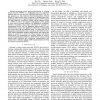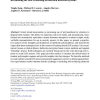225 search results - page 24 / 45 » Defending against Sybil Attacks in Sensor Networks |
INFOCOM
2008
IEEE
14 years 2 months ago
2008
IEEE
—Achieving secure time-synchronization in wireless sensor networks (WSNs) is a challenging, but very important problem that has not yet been addressed effectively. This paper pro...
CCS
2007
ACM
14 years 2 months ago
2007
ACM
Current trends demonstrate an increasing use of polymorphism by attackers to disguise their exploits. The ability for malicious code to be easily, and automatically, transformed in...
ML
2010
ACM
13 years 6 months ago
2010
ACM
Current trends demonstrate an increasing use of polymorphism by attackers to disguise their exploits. The ability for malicious code to be easily, and automatically, transformed in...
NETWORK
2006
13 years 8 months ago
2006
Wireless sensor networks are built upon a shared medium that makes it easy for adversaries to conduct radio interference, or jamming, attacks that effectively cause a denial of se...
COMCOM
2006
13 years 8 months ago
2006
In defending one's network against cyber attack, certain vulnerabilities may seem acceptable risks when considered in isolation. But an intruder can often infiltrate a seemin...


